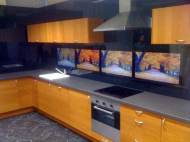Digital kitchen could teach you foreign languages and their cuisine
 If you are one of those persons who like to multitask and train their brain by trying something new, here is a research you might find interesting. Language experts and computer scientists at Newcastle University came up with a digital kitchen which brings language learning out of the classroom and combines it with an enjoyable and rewarding real-life activity.
If you are one of those persons who like to multitask and train their brain by trying something new, here is a research you might find interesting. Language experts and computer scientists at Newcastle University came up with a digital kitchen which brings language learning out of the classroom and combines it with an enjoyable and rewarding real-life activity.
Led by Professor Paul Seedhouse, of the School of Education, Communication and Language Sciences, and Professor Patrick Olivier of the School of Computing Science, the project development involves construction of digital kitchens that speak to the users in French and give them step-by-step instructions on how to prepare French cuisine.
The kitchen builds on the proven technique of Task-Based Language Learning (TBLL), an effective teaching method where students are prompted by instructions in a foreign language to carry out specified tasks. But TBLL has never previously involved instruction in a life skill like cooking, which will help to inspire and motivate users and accelerate their learning.
By using a tablet or laptop computer incorporated into the kitchen, the user first selects the French recipe they want to follow. Digital sensors are built into utensils, ingredient containers and other equipment in order to check if an item is correctly or incorrectly moved, and simultaneously track user actions in order to make sure the right instructions are given at the right time, or to give feedback to the user if they go wrong.
All grammar and vocabulary has been carefully selected to ensure that users learn by performing tasks. After a session, the user can see what they have learned by carrying out a short test on the computer. Participants are equipped with a headset and microphone and can request a repetition or a translation of what the kitchen is saying to them by speech or control from the tablet computer.
“You never really understand something properly until you do it for yourself, and one of the universal problems of classroom language teaching is that students are often rehearsing, rather than actually using the language”, said Seedhouse. “Our overriding objective is to make language learning more enjoyable, more effective and, by linking it to the development of another valuable life skill, more educational too.”
The project has adapted technology that was initially developed for Newcastle University’s Ambient Kitchen. The new kitchen is designed to be installed in schools, universities and even people’s homes and could be available commercially by the end of 2012. The first version of the technology was trialed in the catering kitchens of project partner Newcastle College.
The latest version of digital kitchen is fully furnished and equipped with four screens, one of which is a touch screen. These will be used to display the instructions for our recipes as well as videos and pictures. The digital sensors and RFID tags that will be installed in the kitchen are currently being developed at Culture Lab.
The curriculum will be adapted to various types of learners ranging from beginners to intermediate and more advanced learners. The researchers are also searching for ways to commercialize their idea and plan to develop English, German, Spanish, Italian, Finnish, and Catalan versions. Ultimately, the digital kitchen could be developed for any language and cuisine in the world.









author
You can find out more about the research from the team involved in an audio slide show here.
I like the idea and I see its use in other places. For instance, you could learn how to perform some job and prepare for potential outsourcing in the same time.
This could all end up horribly wrong when used by persons with ADD :)